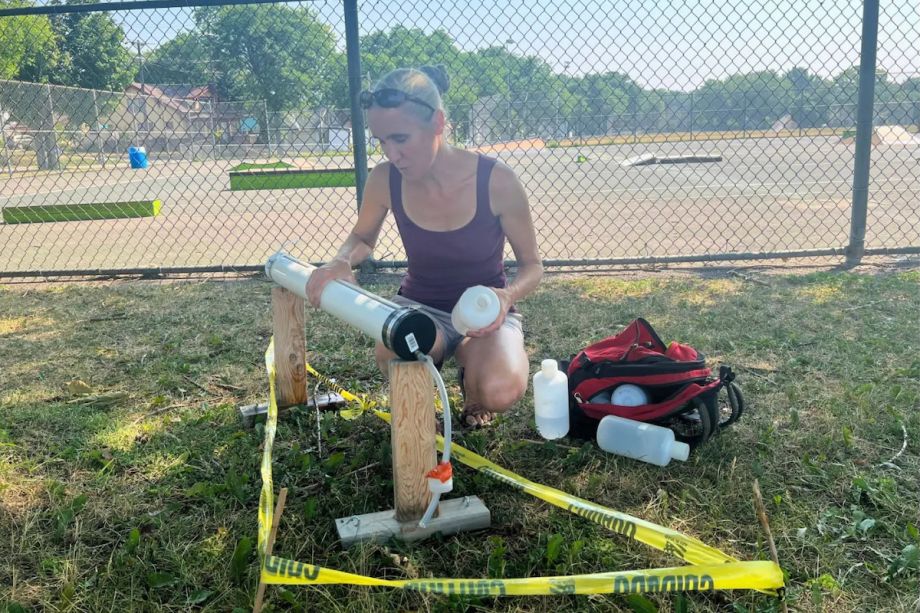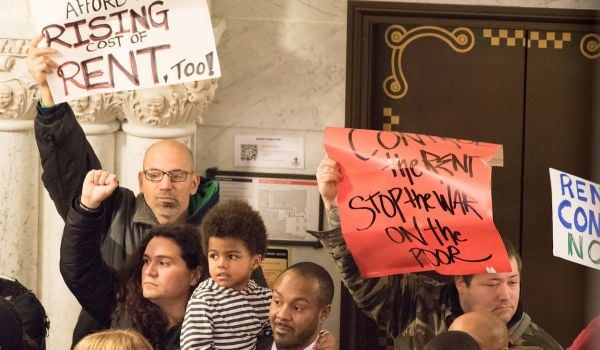This story comes to you from Sahan Journal, a nonprofit newsroom dedicated to covering Minnesota’s immigrants and communities of color. Sign up for Sahan’s free newsletter to receive more stories in your inbox.
Xiating Chen plugged her laptop into a data collection box she’d rigged to an ash tree in St. Paul’s Dayton’s Bluff Park on a hot July morning to measure the flow of water passing through the tree.
Chen, a graduate student from China, is pursuing a doctorate in hydrology, and her thesis project is an attempt to better understand the roles trees play in stormwater management in Twin Cities.
She’s part of a cohort working with associate professor Xue Feng at the University of Minnesota that is using ash trees slated for removal in St. Paul to measure the impact of forestry on urban stormwater quality and quantity.
It’s critical work in Minnesota, where climate change caused by the burning of fossil fuels is creating a warmer and wetter environment, according to data from Minnesota Department of Natural Resources. Recent summers have brought drought, but overall weather trends are tending toward a wetter Minnesota in which large storms are more frequent.
Stormwater management is the study of waterflow in urban areas. When rains hit impervious surfaces like pavement and buildings, it runs into drains and rushes into lakes and rivers much faster than it would in a natural landscape.
That can result in flash floods that rapidly carry polluting chemicals and nutrients into lakes and rivers. Nutrients like phosphorus contribute to harmful algae blooms, which increasingly occur in Minnesota waters and force local governments to close beaches in the summer.
The work is taking advantage of current mass removal of ash trees in Minnesota due to Emerald Ash Borer, an invasive insect that is killing the trees across North America.
A challenge for researchers is that it takes about 20 years for a tree to reach maturity. By looking at the impact of ash trees slated for removal, then comparing those areas after they’re gone, the U of M team can create a shortcut.
“We have this rare opportunity,” said John Bilotta, coordinator at the University of Minnesota’s Stormwater Research Council, a university extension program that aims to facilitate and complete research on urban stormwater.
The research council and the National Science Foundation are funding the U of M stormwater research in St. Paul, which aims to understand the role that tree canopy plays in how water flows through the urban landscape.
“In terms of watershed management in urban areas, trees have not been a prominent feature and focus,” Feng said.
Growing understanding
Randy Neprash is a civil engineer who served as a longtime advisor to the Minnesota Cities Stormwater Coalition, a part of the League of Minnesota Cities that helps local governments meet state and federal stormwater requirements. He said there are major gaps in knowledge about urban watersheds. The field is relatively new, as cities have spent most of their time learning how to remove sewer water and provide clean drinking water. In the United States the study of how stormwater moves through built environments is only about 30 years old, Neprash said.
“We still have an amazing amount to learn,” Neprash said.
For the past 15 years, Napresh has worked on integrating trees with stormwater management. The best way is to build streets and sidewalks that have large root zones underground, and to route stormwater to those root zones. Done right, it offers more benefits than a traditional rain garden at reducing water volume because trees are large and absorbent, he said.
One good example is the root system created along University Avenue in St. Paul when the Green Line light rail was built a decade ago, Napresh said. The project coordinated with the Capitol Region Watershed District to build more than five miles of “tree trenches” adjacent to storm drains with permeable surfaces to draw rainwater into the ground.
Out in the field, Chen and fellow researcher Lucy Rose visit St. Paul parks once a week, gathering throughfall samples and taking measurements from data boxes rigged to trees.
Throughfall, or water that comes to the ground after passing through tree leaves (known as canopy), is measured by setting polyvinyl chloride (PVC) pipes with slits down the middle under dense tree canopy. The water that enters the pipes flows into plastic collection bottles. Those samples are then analyzed for phosphorus, nitrogen, and pollutants.
The researchers then compare those areas to places where rainfall isn’t filtered through tree canopy.
The U of M team in St. Paul is sharing their findings with the city’s planning and forestry departments, and hopes to be a resource for best practices.
“The big picture is for urban forestry and urban watershed planning to come together,” Chen said.
Benefits and burdens
Trees play a critical role in improving air quality and combating the heat island effect in cities. Learning more about how and when to use trees to aid in stormwater management is critical for areas like Minnesota as the climate changes.
“We have to look at trees as a holistic, nature-based solution to climate change problems,” Feng said.
But if trees are not planted correctly, the benefits can come with burdens. Trees planted right along a street without proper space for root systems will not have enough space to grow, and those without buffers between roads will result in more phosphorus and nitrogen in stormwater, which will end up in lakes and rivers. Urban planners and forestry departments should be mindful, Feng said.
This is especially true of trees that are doing heavy lifting on cleaning the air. At Orchard Park in St. Paul’s South Como neighborhood, the trees are close to a heavy rail line. The throughfall there has high levels of phosphorus, which is good from an air filtration standpoint, but bad for stormwater filtration.
“The health conditions of the trees vary across parks,” Chen said.
Large scale ash tree removal is a massive climate challenge for forestry departments in Minnesota. But there is also an opportunity to replant those trees in ways that best benefit urban environments, Feng said.
Andrew Hazzard is a staff reporter with Sahan Journal who focuses on climate change and environmental justice issues. After starting his career in daily newspapers in Mississippi and North Dakota, Andrew returned to Minneapolis where he worked for local publications such as Southwest Journal. He is a graduate of the University of Missouri School of Journalism and a member of the Society of Environmental Journalists. Andrew enjoys travel, speaks Spanish, and is a depressed supporter of Minnesota's professional sports teams. He and his wife live in Minneapolis.








_600_350_80_s_c1.JPEG)







